Items Similar to Australian Abstract Expressionist Oil Painting
Want more images or videos?
Request additional images or videos from the seller
1 of 13
David RankinAustralian Abstract Expressionist Oil Painting1990
1990
$12,500
£9,528.71
€10,885.81
CA$17,589.26
A$19,265.70
CHF 10,143.39
MX$229,929.68
NOK 129,268.43
SEK 118,170.83
DKK 81,346.28
About the Item
David Rankin is a New York-based, British-born Australian post-war and contemporary artist known for his expressionistic abstract paintings. His work can be categorized by his use of quick, loose brushstrokes, reminiscent of scribbles on a page. Rankin works predominantly in oil painting and acrylic on canvas, but also works with paper, prints, sculptures and ceramics. Rankin has held over 100 one-person exhibitions in cities across the world, including New York, London, Paris, Beijing, Mexico, Vienna, Berlin and Cologne, as well as all over Australia. Represented in many of the world’s leading public and private collections and museums, David Rankin’s work is featured in Australia’s leading institutions, including the National Gallery of Australia, Art Gallery of New South Wales, National Gallery of Victoria and Queensland Art Gallery.
David Rankin was born in Plymouth, Devon, England in 1946 then emigrated to Australia with his family in 1948. He spent his childhood in the 1950s in the semi-rural Port Hacking region South of Sydney and his teenage years in country New South Wales, from Hay, Wagga Wagga and Albury in the South to Bourke and Brewarrina in the North.
Rankin is self-taught, developing his techniques and ideas in the outback towns of his youth. He was inspired by the greats from Leonardo da Vinci to Paul Klee as well as being influenced by the history of Buddhism and Asian art. In his travels before he arrived in Sydney in 1967 he developed a concept of what he wanted to achieve as an Australian artist. His dream was to express the anima, the life spirit or the essence of God in all nature. As an Australian artist he believed could bring the elements of Western Art together with an understanding and love for the cultures of Asia and the Australian Aborigine. He also felt that as Australia was closer to Asia than Europe it made sense to think about the art of Indian, Chinese and Japanese artists, and that one could not be an authentic articulate Australian artist without a love and respect for the artistic and spiritual expressions of the various Aboriginal artists, peoples and cultures. His work combined elements of Abstract Expressionist painting with Jewish and Aboriginal influences.
In 1979 his first wife, Jennifer Mary Roberts (née Haynes) died. Rankin subsequently met his current wife Lily Brett, whose own life was etched by tragedy with her parents being survivors of the Holocaust. She too migrated to Australia as a child after the Second World War in 1948. The artist recounts that his empathy for Lily and the pity for his first wife's death fused into what he calls "the dark blessing of my life." The darkness was transformed into images. The author Dore Ashton writes that the events of 1979 and the fire which ravished his studio in 1997 and burnt his art works and many personal possessions, had a profound impact on his work.
Having personal life experiences as his subject matter, Rankin's paintings contemplate these things. For example, his Jerusalem series followed a trip to Jerusalem in 1988, which then led to his Golgotha works. His travels to the Australian, American and Mexican deserts became the subject matter for many of his canvases, such as Ridge – Mungo, Golden Prophecy – San Antonio, Grey Sonora Landscape and then led to his Witness Series. From the fire in his studio he then painted Buddha and Flames. He illustrated two books by Lily Brett on the holocaust and explored the theme further in his huge work The Drowned and The Saved from a book by Primo Levi of the same name. Through Brett he encountered Jewish mythology and painted judaica imagery, Black Menorah and Black Tefillin and as a testament to his love for her created his Husband and Wife Series including Husband and Wife Triptych III, and Husband and Wife – Ying and Yang.
In 1989 Rankin moved with his wife to New York City. From their home in New York they continue to explore both their Australian roots and culture and the opportunities and challenges of being part of an international community. Their three children, including celebrated artist Jessica Rankin, also live in New York. David's daughter-in-law is artist Julie Mehretu.
In the past 30 years Rankin has held over 100 one-person exhibitions in cities including Paris, Beijing, New York, Cologne and throughout Australia. He is represented in many of the world's leading collections and museums, including the National Gallery of Victoria. He was selected as Australia's official representative in the UNESCO Fortieth Anniversary Exhibition celebrations that toured the world's capitals. He was featured in the Salon de Mai in Paris and the Chicago Art Fair. Among the many prizes and awards he has been honored with is the 1983 Wynne Prize, Australia's premier landscape prize. Recently an English-German monograph on his work titled "The Walls of the Heart: The Work and Life of David Rankin" was published by US critic and art historian Dore Ashton. In 2005-2006 a major exhibition of Rankin's art, curated by Dore Ashton, toured through public galleries in Australia.
Among his many commissioned works are The Scorched Earth, 1984–85, oil on canvas, diptych at the Victorian Arts Centre, Melbourne. The Committee for Bosnia, commissioned a poster, A Day for Bosnia, at The University of Chicago. His oil paintings, large watercolours and ceramics appear at the New York Vista Hotel.
In September 2013, a book by Dore Ashton on David Rankin's work titled David Rankin: The New York Years was released.
He has shown his work at Charles Nodrum Gallery, Richmond, Australia, Mossgreen Gallery and other leading Australian galleries.
- Creator:David Rankin (1946, Australian)
- Creation Year:1990
- Dimensions:Height: 61 in (154.94 cm)Width: 41 in (104.14 cm)
- Medium:
- Movement & Style:
- Period:
- Condition:
- Gallery Location:Surfside, FL
- Reference Number:1stDibs: LU38215582292
About the Seller
4.9
Platinum Seller
Premium sellers with a 4.7+ rating and 24-hour response times
Established in 1995
1stDibs seller since 2014
1,846 sales on 1stDibs
Typical response time: 1 hour
- ShippingRetrieving quote...Shipping from: Surfside, FL
- Return Policy
More From This Seller
View AllAustralian Abstract Expressionist Gouache Painting Charcoal on Shaped Paper
By David Rankin
Located in Surfside, FL
David Rankin
American (b. 1946)
Untitled (Black on gray) (1990)
Gouache and charcoal on paper
signed lower left
19 x 15 inches
Rankin is a New York-based, British-born Australian p...
Category
1990s Abstract Expressionist Abstract Paintings
Materials
Canvas, Oil
Untitled Composition Abstract Expressionist Oil Painting Jay Milder
By Jay Milder
Located in Surfside, FL
Jay Milder (American, 1934-)
Oil painting on Canvas
Hand signed lower right
Dated 1960
This is being sold unframed
Abstract with letters and calligraphy, Homage to Cy Twombly.
Jay ...
Category
1960s Abstract Expressionist Abstract Paintings
Materials
Canvas, Oil
Large Colorful MCM Abstract Expressionist Oil Painting Modernist Ralph Rosenborg
By Ralph Rosenborg
Located in Surfside, FL
Ralph Rosenborg (American, 1913-1992) Mountain Weed with Two Clouds, oil on jute canvas, canvas is hand signed recto and verso, artists label and Snyder Fine Art gallery label, The p...
Category
1960s Abstract Expressionist Abstract Paintings
Materials
Canvas, Jute, Oil
A Glazing Medley, Abstract Expressionist Oil on Canvas Painting
Located in Surfside, FL
Inn the manner of the Hans Hofmann School. A great older Abstract Expressionist painting.
Category
20th Century Abstract Expressionist Abstract Paintings
Materials
Canvas, Oil
Untitled Large Abstract Expressionist Color Oil Painting Tom Lieber
By Tom Lieber
Located in Surfside, FL
In 1974, Tom Lieber attended the University of Illinois and earned his M.F.A. Lieber then moved to San Francisco to fulfill his afinity with Ba...
Category
1980s Contemporary Abstract Paintings
Materials
Canvas, Oil
Bold Graphic Abstract Expressionist Mixed Media Painting Richard Snyder NYC Art
Located in Surfside, FL
Richard Snyder (American, born 1951)
Untitled
Mixed media painting including oil
Hand signed to lower right on the back
Dimensions: 22.5" W x 30.0" H x 0.1" D
Richard Snyder is particularly known for his large-scale abstract expressionist paintings exhibiting vibrant colors, often applied in an irregular manner with large gestural brushstrokes. He also was an accomplished sculptor and was amongst the downtown New York art-furniture scene spawned in the 1980s by the Soho gallery ‘Art et Industrie’ founded by Rick Kaufmann. Downtown New York, circa 1977-1980 was a hothouse of creative impulses that flew in the face of restrictions and ran headlong toward riotous expression. Punk, hip-hop, graffiti or neo-expressionism,
Kaufmann looked around for new talent that could create a new kind of art furniture. He felt the design of the day was so standardised, and he wanted to give voice to young artists and bring new ideas to market.
After receiving a BFA from the School of the Museum of Fine Arts in Boston, Snyder made his career in the fields of art and design, practicing sculpture, painting, furniture design and fabrication, interior design, cabinetmaking, construction and industrial design. Along with extensive experience in a wide variety of materials and processes, Snyder also possesses a wide range of visual and experiential vocabulary acquired in his many travels through the Americas, Africa, the Middle East and Central and Southeast Asia. Snyder considers his objects to be not just about form, function, color, material and process, but rather to be fantasies with spirit, magic and story. During his seventeen years with the Art et Industrie gallery, Snyder participated in five solo shows and more than twenty group shows, which established him as a major player in the American Art Furniture movement. His pieces have appeared in numerous publications and media around the world; and they are included in numerous private collections worldwide as well as in the permanent collection of The Art Institute of Chicago. Snyder guest-lectures at the Rhode Island School of Design in Providence, the New School in New York, and SUNY Purchase.
He was included in the seminal Magen H Gallery retrospective of Art et Industrie—a New York Movement. Art et Industrie was the first to exhibit Studio Alchemia, Shiro Takahama, and Ron Arad.
The retrospective included artists such as Forrest Myers, Terence Main...
Category
20th Century Abstract Expressionist Abstract Paintings
Materials
Oil
You May Also Like
Large French Expressionist Abstract Oil Painting
By Armand Rottenberg
Located in Cirencester, Gloucestershire
Expressionist Composition
by Armand Rottenberg (French 1903-2000)
signed lower corner, dated 1990
oil painting on board, framed
Framed 28.5 x 17.5 inches
Stunning original abstract...
Category
Late 20th Century Abstract Expressionist Abstract Paintings
Materials
Oil
Dark Modern Abstract, French Artist, Original Oil Painting
By Franck Duminil
Located in Cirencester, Gloucestershire
Dark Modern Abstract, French Artist, Original Oil Painting
By French artist Franck Duminil (1933-2014)
Signed by the artist verso
Oil painting on canvas, unframed
Canvas size: 19 x 1...
Category
Mid-20th Century Abstract Abstract Paintings
Materials
Oil
French Expressionist Abstract Oil Painting
By Yvette Dubois Habasque
Located in Cirencester, Gloucestershire
Abstract
by Yvette Dubois-Habasque (1929-2016)
signed and dated verso and signed with initials in lower right
oil painting on artists board, unframed
painting measures: 15.75 x 12 i...
Category
21st Century and Contemporary Abstract Expressionist Abstract Paintings
Materials
Oil
French Expressionist Abstract Oil Painting
By Yvette Dubois Habasque
Located in Cirencester, Gloucestershire
Abstract
by Yvette Dubois-Habasque (1929-2016)
signed with initials and dated verso
oil painting on artists board, unframed
painting measures: 13.75 x 10.75 inches
Stunning origina...
Category
21st Century and Contemporary Abstract Expressionist Abstract Paintings
Materials
Oil
French Expressionist Abstract Oil Painting
By Yvette Dubois Habasque
Located in Cirencester, Gloucestershire
Abstract
by Yvette Dubois-Habasque (1929-2016)
dated verso and signed with initials
oil painting on artists board, unframed
painting measures: 10.75 x 13.75 inches
Stunning origin...
Category
21st Century and Contemporary Abstract Expressionist Abstract Paintings
Materials
Oil
Large Multi Coloured French Expressionist Abstract Oil Painting
By Armand Rottenberg
Located in Cirencester, Gloucestershire
Large Multi Coloured French Expressionist Abstract Oil Painting
by Armand Rottenberg (French 1903-2000)
oil painting on board, framed
Framed 37.5 x 27 inches
Stunning original abs...
Category
Late 20th Century Abstract Expressionist Abstract Paintings
Materials
Oil
More Ways To Browse
Devon England
Hotel Book
Oil Paintings Australia
Chicago Oil Painting
Australian Oil Painting
Judaica Menorah
Page Oil Painting
1960 Fenton
3 Dimensional Wood Art
60x30 Painting
Abstract Ocean Sky Painting
Abstract Painting 1940 France
Alan Reynolds
Ali Enache
Alma Woodsey Thomas
Amy Meyer
Andee Axe
Art Concrete Construction








